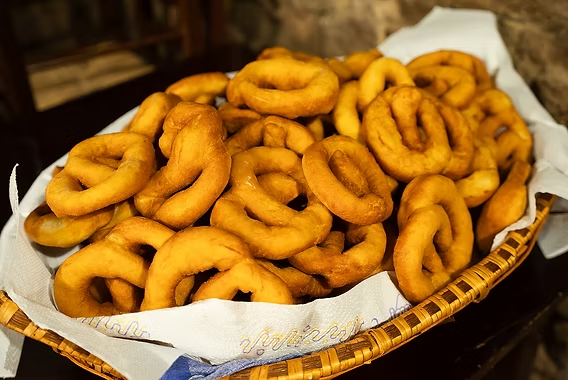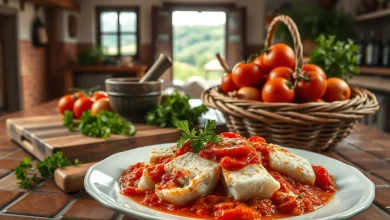Peaches of Prato (Pesche di Prato)
Category: Desserts
Serves: 20
Ingredients
For the dough (Biga):
| Ingredient | Quantity |
|---|---|
| All-purpose flour (00) | 225g |
| Water | 80g |
| Sugar | 37g |
| Butter | 30g |
| Eggs | 17g |
| Fresh brewer’s yeast | 17g |
| All-purpose flour (00) | 375g |
| Eggs | 250g |
| Sugar | 70g |
| Butter | 40g |
| Acacia honey | 30g |
| Salt | 9g |
| Orange zest | 5g |
| Vanilla bean | 1 |
| Whole milk | 375g |
| Fresh cream | 125g |
| Sugar | 140g |
| Egg yolks | 120g |
| All-purpose flour (00) | 20g |
| Cornstarch (Maizena) | 20g |
| Lemon zest | 1 |
| Vanilla bean | ½ |
| Salt | 1g |
For the syrup (Bagna):
| Ingredient | Quantity |
|---|---|
| Water | 500g |
| Sugar | 450g |
| Alchermes liqueur | 175g |
| Glucose syrup | 50g |
| Candied orange peel | To taste |
Directions
Step 1: Preparing the Biga (Starter Dough)
Start by preparing the biga (starter dough). In a large bowl or using a stand mixer with a dough hook, combine 225g of flour, 37g of sugar, and 30g of butter. Crumble the fresh yeast and add it to the mixture. Stir the ingredients together until evenly combined. If the dough is too stiff, add a little more water (from the remaining 80g) to adjust the consistency. Don’t overwork the dough; it’s important that it remains homogenous. Shape the dough into a ball and cover it with the remaining 375g of flour. Allow it to rise for about 1 to 1.5 hours.
Step 2: Preparing the Main Dough
Once the biga has risen, transfer it to the bowl of a stand mixer. Add the remaining sugar, almost all of the eggs (reserve a small portion for brushing), honey, and the zest of one orange. Stir on low speed until the ingredients begin to come together. Gradually add more eggs as needed to achieve a smooth and slightly soft dough. The dough should not be too stiff, so add just enough to create a soft, homogenous mixture.
Increase the speed of the mixer and continue mixing until the dough pulls away from the sides of the bowl and becomes smooth, dry, and well incorporated. To test for proper gluten development, pinch a small piece of dough and stretch it between your fingers. If it doesn’t tear and is elastic and translucent, it’s ready.
Transfer the dough to a work surface, using a dough scraper if necessary. Gently shape it into a ball and place it back in the bowl. Sprinkle with flour, cover, and let it rise for about 2 hours until it has almost tripled in volume.
Step 3: Shaping the Dough
After the dough has risen, transfer it to a lightly floured work surface. Divide the dough into five portions of approximately 100g each. Roll these portions into regular logs, then cut each log into eight equal pieces, weighing about 12g each. Roll the small portions into smooth balls and place them on a baking sheet lined with parchment paper, making sure to leave space between them.
Gently flatten each ball with your fingers, then let them rest for 10 minutes. After the resting period, lightly press them again to form semi-spherical shapes. Cover the tray with plastic wrap or a kitchen towel and allow the dough to rise for another 2 hours. The balls should almost triple in size.
Step 4: Baking the Dough
Preheat the oven to 200°C (390°F) with the convection setting off. Bake the dough for 6 to 7 minutes, or until they have a light golden-brown color resembling honey or hazelnut. Remove from the oven and let them cool completely.
Step 5: Preparing the Custard Cream
To make the custard, combine the milk, cream, and a few pieces of lemon zest in a saucepan. Add half of the sugar and a pinch of salt. Heat the mixture gently, bringing it just to the point of simmering, but avoid letting it boil. In a separate bowl, whisk together the egg yolks with the remaining sugar until smooth.
Once the milk mixture reaches a gentle simmer, remove the lemon zest and pour the milk mixture into the egg yolks while whisking constantly. Return the mixture to the stovetop and cook over low heat, stirring continuously, until the custard thickens and forms a smooth consistency. Once it reaches the desired thickness, remove it from the heat and transfer to a bowl. Let the custard cool, then place it in a piping bag without a nozzle and refrigerate until ready to use.
Step 6: Preparing the Syrup
To make the syrup, combine the water and sugar in a saucepan. Heat until the sugar dissolves and the mixture begins to bubble. Let it reach a full boil, then remove from the heat and allow it to cool to room temperature. Once cooled, stir in the Alchermes liqueur. The syrup should be at a temperature of 30-35°C (86-95°F) when you’re ready to dip the pastries.
Step 7: Assembling the Peaches of Prato
Once the dough balls have cooled, make a small incision at the base of each pastry using the tip of a knife. Gently widen the opening with your thumb. Submerge the pastries one by one in the syrup, ensuring they are well-soaked. You can weigh each pastry to confirm it absorbs about 12g of syrup.
After soaking, pipe approximately 6g of the custard cream into each pastry, followed by another 6g on top. Carefully sandwich the two halves together, making sure they fit neatly with the custard slightly oozing out the sides.
Step 8: Final Decoration
To finish, decorate each pastry with a small piece of candied orange peel, simulating the “stem” of a peach. Serve and enjoy your delicious, homemade Peaches of Prato!
Notes
Peaches of Prato are a traditional Italian dessert that combines soft, airy dough with a rich custard filling, and are often flavored with the signature Alchermes liqueur. The delicate balance of textures and flavors makes these treats perfect for special occasions, but they also make an excellent homemade indulgence to enjoy with coffee or tea.





